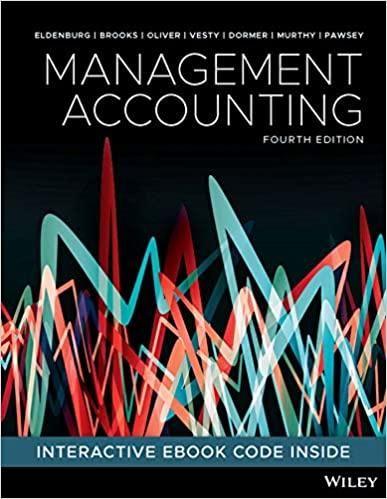The Fairyland Childrens Centre is a community-based, not-for-profit childcare service. A committee of management oversees its operations,
Question:
The Fairyland Children’s Centre is a community-based, not-for-profit childcare service. A committee of management oversees its operations, with the elected members being parents of children attending the centre. The centre is licensed to operate with 50 effective full-time places. Due to the preference for part-time care, there are only seven places filled on a full-time basis. From 1 July 2019, a wage increase has been granted to employees. This wage increase could significantly impact the continuing viability of the Fairyland Children’s Centre.
The employees have won wage increases of up to $148 per week, which are to be phased in over 18 months as shown below.
1 July 2019 ......................................... 2% increase
31 December 2019 ........................... 2% increase
1 July 2020 ......................................... 2% increase
31 December 2020 .......................... 4% increase
The first round of increases is to be paid from 1 July 2019, with the remaining increases to be phased in over the next 18 months. The new wage rates are based on a 38-hour week; however, the Fairyland Children’s Centre’s Committee of Management varied its employees’ conditions of employment some years ago to a 35-hour week. The current wages bill is $600 000 per year.
The wage cost for the Fairyland Children’s Centre is influenced by the minimum staffing requirements as set out in regulations issued by the government. The ratio of staff members to children is dependent upon the number of children in particular age groups. This has been one of the factors influencing how the centre has distributed its 50 registered places to each age group, coupled with the space requirements for each age group and the constraints due to the configuration of the rooms in the centre. The places have been divided into four age groups: 6 months to 2 years, 2 years to 3 years, 3 years to 4 years, and 4 years to 5 years. The following table gives a breakdown of the centre’s room structure, the number of places allocated to each age group and the minimum staffing requirements for each age group as set in the government’s regulations.

As the minimum staffing requirements must be maintained at all times, additional staff are employed to cover staff absences due to lunch breaks, educational planning sessions, rostered days off, sick leave, annual leave, long service leave, and to maintain ratios at the beginning and end of each day.
As the centre is a not-for-profit concern, any surpluses that are accumulated fund future asset acquisitions or are applied in future years to absorb budget deficits. The centre’s financial year runs from 1 January to 31 December. When setting the 2019 budget, the committee was aware that a wage increase was likely to be approved from 1 July but they did not know the exact amount. Therefore, the committee factored an average $25 per week increase per full-time employee (prorated for part-time employees), and $6.50 per day for agency relief staff into the budget. As a result, the 2019 budget incorporated a weekly fee set at $220 and a daily fee at $55 until 30 June, and then $230 per week and $57 per day from 1 July. A higher daily fee is charged for part-time places due to the additional costs incurred in administration activities associated with health and safety regulations and the likelihood that any vacancies will take longer to fill. In recent years, the centre’s director, Tina West, has found it difficult to fill single-day vacancies.
Tina West organised a special meeting of the committee to discuss the impact of the wage increase on the centre. Tina commenced the meeting by giving everyone the background to the wage increase and the details regarding the phasing in of payments and the new classification structure. She explained that managers at local centres in the area are agreeing to pay the full increase immediately rather than in increments as given in the determination. The reason given to justify the full payment now is both to attract and retain staff. In recent years, the ability to recruit qualified staff has been problematic, as many potential employees have sought occupations outside the childcare industry due to the low remuneration. Coupled with this is the centre’s current employees’ push for the full wage increase to be paid now, or at a minimum to have more than just the first stage payment made from 1 July 2019.
The committee is more than aware of the difficulties in recruiting suitable staff. Over the past two years, several positions have been advertised with few applicants. In fact, the director’s position took over three months to fill. In the end, the assistant director at the time was promoted to the director’s position, as no external applicants were deemed suitable. Although the committee is pleased that they anticipated the first stage of the wage increase and incorporated it into the 2019 budget, they are still concerned about the overall wage increase on the centre. Committee members expressed concern about paying the future wage increases in advance, and the reaction of parents to a fee hike, especially if this is greater than other childcare centres in the area. The financial viability of the centre could be jeopardised if parents withdraw their children and vacant places cannot be filled quickly.
Required
(a) Draw on the circumstances relating to Fairyland Children’s Centre to outline the problems associated with estimating revenue in budget preparation.
(b) Comment on how the estimation of revenue is likely to affect cost planning at Fairyland Children’s Centre.
Step by Step Answer:

Management Accounting
ISBN: 9780730369387
4th Edition
Authors: Leslie G. Eldenburg, Albie Brooks, Judy Oliver, Gillian Vesty, Rodney Dormer, Vijaya Murthy, Nick Pawsey





